HITLER REVIEWS ARMY UNITS NEAR LENINGRAD
On the Eastern Front · July 27, 1941
On this date in 1941, five weeks after the launch of Operation Barbarossa, Nazi Germany’s surprise attack on the Soviet Union, Adolf Hitler paid a visit to the headquarters of Army Group North. Led by Field Marshal Wilhelm von Leeb (1876–1956), Army Group North had begun its first attack on Leningrad (present-day St. Petersburg) the month before, when it abruptly halted some 60 miles south of the city.
Leeb’s stop order infuriated Hitler. He once privately described the no-nonsense practicing Catholic as an “incorrigible anti-Nazi” and placed Leeb under Gestapo (secret police) surveillance. Nevertheless, Hitler valued Leeb’s martial skills sufficiently to recall the general from retirement in 1939 for the invasion of Poland, and the next year, 1940, he placed Leeb in command of Army Group C during the invasion of France and the Low Countries. Leeb’s army, now designated Army Group North, was tasked with destroying Soviet forces in the Baltic States and then driving on to Leningrad. The city—the Soviet Union’s second largest—was chiefly prized militarily because it lay across the path of the Germans’ advance into the north of Russia.
During his July 1941 visit to Army Group North Hitler ordered Leeb to take the city by December. Six weeks later Leeb’s army had the city completely encircled. Within days Hitler reversed himself and ordered Leeb not to take the city. Leningrad must be erased from the face of the earth by starvation, Hitler told the troops in September, not by full-scale assault; he had no interest in saving the lives of its civilian population. “Requests for surrender resulting from the situation of the city will be rejected, as the problem of housing and feeding the population cannot and should not be solved by us.”
Between January 1942, the month Leeb was relieved of command, and January 1944, Soviet defenders launched several counteroffensives, but the nightmarish 872‑day siege of Leningrad—the longest siege in modern history—was only lifted on January 27, 1944, in part because Wehrmacht misfortunes elsewhere along the Eastern Front drained manpower and materiel from around Leningrad. Some 2.5 million Leningraders endured the siege and a little less than half of them (1.1 to 1.3 million by the best estimates) died from the ceaseless shelling and aerial bombing or were victims of starvation, disease, and exposure to the brutal cold.
German Siege of Leningrad, September 8, 1941, to January 27, 1944
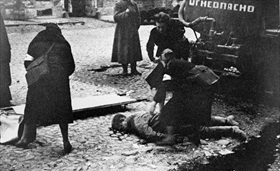 | 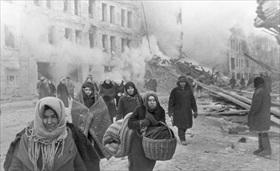 |
Left: Nurses help people wounded in the first bombardment of Leningrad, September 10, 1941. Of the roughly 30,000 medical doctors and 100,000 medical nurses in prewar Leningrad, less than half survived the siege.
![]()
Right: Citizens of Leningrad leave their homes destroyed by German bombing, December 10, 1942. Between June and September 1942, Germans stationed newer and heavier artillery capable of firing 800 kg (1,764 lb) shells 6–16 miles from the city. They made special maps of the city for artillery bombardments, targeting city infrastructure, businesses, transportation, schools, and hospitals. Additionally, hundreds of Luftwaffe bombers dropped incendiary and high-explosive bombs on the city. During the horrific siege 3,200 residential buildings, 9,000 wooden houses, and 840 factories and plants were destroyed in Leningrad and suburbs, leaving the city a “ghost city” of thousands of ruined and abandoned buildings.
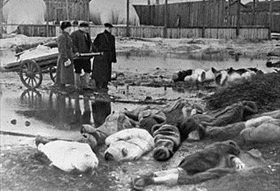 | 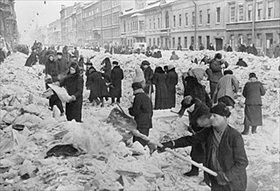 |
Left: Leningraders struggled to stay alive and defend their city in the most appalling conditions. They were bombed, shelled, starved, and frozen. They dug tank traps and trenches, built shelters and fortifications, fought fires, cleared rubble, tended the wounded, and, for as long as they had strength to do so, buried their dead. Many (3 percent) were killed by bombs or shells, but most (97 percent) died of hunger and cold. Here three men are seen burying victims of Leningrad’s siege, October 1, 1942.
![]()
Right: This photo shows citizens of Leningrad clearing a street after the first winter in the besieged city, March 8, 1942. For the defense of the city and tenacity of the civilian survivors of the siege, Leningrad was the first city in the former Soviet Union to be awarded the title of a Hero City in 1945.
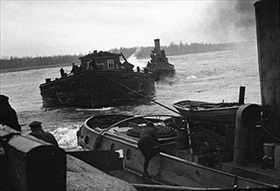 | 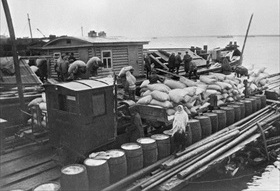 |
Left: On September 22, 1941, Hitler issued Directive No. 1601, ordering the starvation of Leningrad’s defenders. In May 1942 the Soviets began using boats on nearby Lake Ladoga to make food deliveries to the starving survivors. In Germany not much is said about the fate of wartime Leningrad. In the minds of most people, Stalingrad, Dresden, and Hiroshima are considered the largest city disasters of the Second World War. However, the siege of Leningrad caused the death of about twice as many civilians as died in Germany from Allied air attacks during the entire war.
![]()
Right: Foodstuffs delivered to besieged Leningrad on a barge on Lake Ladoga, September 1, 1942. Total civilian death toll in the second year of the siege was about 500,000 citizens. January and February 1942 were the deadliest months of the siege; every month 130,000 civilians were found dead in Leningrad and its suburbs. Part of the civilian population was evacuated from Leningrad, although many died in the process. Some were evacuated to Siberia, where they died. Only 700,000 people were left alive out of a 3.5 million prewar population. Among them were soldiers, workers, surviving children, and women. Some 300,000 of the 700,000 survivors were soldiers who came from other parts of the country to help defend the besieged city. Land mines left by the Germans caused thousands of deaths among returning citizens.
Siege of Leningrad, 1941–1944 (Skip first 30 seconds)
![]()

 History buffs, there is good news! The Daily Chronicles of World War II is now available as an ebook for $4.99 on Amazon.com. Containing a year’s worth of dated entries from this website, the ebook brings the story of this tumultuous era to life in a compelling, authoritative, and succinct manner. Featuring inventive navigation aids, the ebook enables readers to instantly move forward or backward by month and date to different dated entries. Simple and elegant! Click
History buffs, there is good news! The Daily Chronicles of World War II is now available as an ebook for $4.99 on Amazon.com. Containing a year’s worth of dated entries from this website, the ebook brings the story of this tumultuous era to life in a compelling, authoritative, and succinct manner. Featuring inventive navigation aids, the ebook enables readers to instantly move forward or backward by month and date to different dated entries. Simple and elegant! Click 











